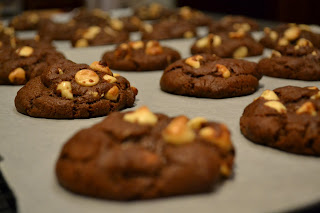What better way to warm the cockles of the heart in deepest, darkest winter than with a slice (or two) of homemade pie? Lately my pie of choice has been the humble apple pie.
Perfectionist that I am, I’ve put a lot of effort into working out how to end up with apple filling that, while not looking like complete goo, has no “crunch” left in it. I mean, if Sara Lee can do it, why can’t I?
I Googled high and low for an answer, but every forum I found was discussing the opposite of my question – offering suggestions on how to keep a pie from being too gooey and too mushy. So I set out to do the footwork by myself.
After trying golden delicious, red delicious, royal gala, granny smith, fuji; not pre-cooked, slightly pre-cooked, completely stewed; roughly chopped, diced, thinly sliced; and various combinations of all of the above, my mind is made up. I’m hope you’re not too disappointed with what I discovered: my best result came from using tinned pie filling. For serious. It’s the holy grail of apple pie. Here’s a photo of some.
If you’re turning up your nose at the very notion of using tinned apples, see my “Tips” section at the bottom of this post for an alternative. But because I don’t like any “crunch” at all in my pies, I’m sticking to the tinned stuff.
Ingredients
250 g unsalted butter, chopped
600 g plain flour
1 tsp salt
(Up to) 6 Tbs cold tap-water
3 x 400 g tins sliced apple pie fruit
250 g caster sugar
2 tsp ground cinnamon
1 egg
1 Tbs milk
Extra caster sugar for sprinkling
Method
- Grease a 23 cm pie tin or tart tin.
- In an electric mixer set on low speed, mix together flour, butter and salt until a sandy consistency. Without stopping the mixing, add 2 Tbs tap water and allow to mix in completely, then repeat with another 2 Tbs tap water. The mixture should start coming together a little bit; add up to another 2 Tbs tap water (so that’s 6 Tbs in total) until the dough comes together in a few large lumps. Be careful not to add more water than you need.
- Turn off the mixer and push the dough together into a ball with your hands. Wrap the ball of dough in cling film and leave to rest for 1½ hours.
- Preheat oven to 170ºC. Empty the cans of tinned apple into a large bowl and stir in caster sugar and ground cinnamon.
- Place a bit more than half the dough on a lightly-floured bench or board, and roll out into a rough circle shape about 3 mm-thick with a rolling pin. Using the rolling pin underneath the dough to support it evenly, carefully lift the dough into the prepared pie tin. Shape the dough into the tin, lightly pressing it into corners and over the edges.
- Pour in the apple mixture.
- Whisk the egg and milk together in a cup with a fork. Using a basting brush, baste the overhanging rim of the pie with egg and milk mixture (this will help “glue” the lid on later). Retain the egg and milk mixture for use in Step 8.
- With the remaining dough, repeat Step 5 to create the pie lid and carefully lift it on top of the pie. Cut around the outside of the pie with a sharp knife to remove excess pastry. Shape the excess pastry into shapes such as leaves, and press patterns into them with the blunt edge of the knife. Firmly press the tines of a fork all the way around the edge of the pie seal the “lid” shut and to decorate. Thoroughly baste the entire top of the pie with the egg and milk. Add the leaf decorations to the top of the pie, then baste them also.
- Sprinkle extra caster sugar over the top of the pie. Use the sharp knife to make at least 3 small slits in the pastry through which air can escape through during cooking.
- Bake in preheated oven for 35–40 minutes. Serve hot or cold with cream or ice cream.
Serves 8
 |
| sandy consistency |
Tips
- If you really don’t want to use tinned apples, instead create your own filling from 1.3 kg of peeled, chopped apples. Stew them in a large saucepan over low heat in a small amount of water until the apples reach your desired consistency. Drain if necessary. Cool apples, then stir in caster sugar and cinnamon.
- The best “real apple” to use in apple pies is supposedly the granny smith, but I think the golden delicious and sun downer taste even better. And you don’t have to stick with one type of apple – mix together two or three of your favourites.
- If you realise you haven’t rolled your pastry thinly enough and it’s not going to be big enough, don’t try to “make do”! Put it back on the bench and keep rolling until it is big enough. A bit of extra handling isn’t going to kill it.
 |
| Remove excess pastry with a sharp knife |
 |
| Press the tines of a fork into pasty edge to decorate |












































